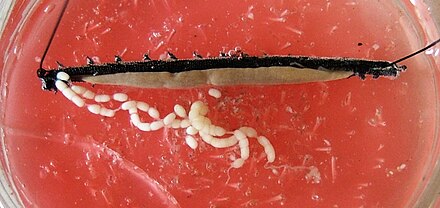Onychophora
Onychophora /ɒnɪˈkɒfərə/ (from Ancient Greek ονυχής, onyches, "claws"; and φέρειν, pherein, "to carry"), commonly known as velvet worms (due to their velvety texture and somewhat wormlike appearance) or more ambiguously as peripatus /pəˈrɪpətəs/ (after the first described genus, Peripatus), is a phylum of elongate, soft-bodied, many-legged panarthropods.[1][2] In appearance they have variously been compared to worms with legs, caterpillars, and slugs.[3] They prey upon smaller animals such as insects, which they catch by squirting an adhesive slime.
Approximately 200 species of velvet worms have been described, although the true number of species is likely greater. The two extant families of velvet worms are Peripatidae and Peripatopsidae. They show a peculiar distribution, with the peripatids being predominantly equatorial and tropical, while the peripatopsids are all found south of the equator. It is the only phylum within Animalia that is wholly endemic to terrestrial environments.[4][5] Velvet worms are generally considered close relatives of the Arthropoda and Tardigrada, with which they form the proposed taxon Panarthropoda.[6] This makes them of palaeontological interest, as they can help reconstruct the ancestral arthropod. In modern zoology, they are particularly renowned for their curious mating behaviour and for bearing live young.
Velvet worms are segmented animals with a flattened cylindrical body cross-section and rows of unstructured body appendages known as oncopods or lobopods (informally: stub feet). The animals grow to between 0.5 and 20 cm (.2 to 8 in), with the average being about 5 cm (2 in), and have between 13 and 43 pairs of legs. Their skin consists of numerous, fine transverse rings and is often inconspicuously coloured orange, red or brown, but sometimes also bright green, blue, gold or white, and occasionally patterned with other colours. Segmentation is outwardly inconspicuous, and identifiable by the regular spacing of the pairs of legs and in the regular arrangement of skin pores, excretion organs and concentrations of nerve cells. The individual body sections are largely unspecialised; even the head develops only a little differently from the abdominal segments. Segmentation is apparently specified by the same gene as in other groups of animals, and is activated in each case, during embryonic development, at the rear border of each segment and in the growth zone of the stub feet. Although onychophorans fall within the protostome group, their early development has a deuterostome trajectory, (with the mouth and anus forming separately); this trajectory is concealed by the rather sophisticated processes which occur in early development.[7]
The stub feet that characterise the velvet worms are conical, baggy appendages of the body, which are internally hollow and have no joints. Although the number of feet can vary considerably between species, their structure is basically very similar. Rigidity is provided by the hydrostatic pressure of their fluid contents, and movement is usually obtained passively by stretching and contraction of the animal's entire body. However, each leg can also be shortened and bent by internal muscles.[8] Due to the lack of joints, this bending can take place at any point along the sides of the leg. In some species, two different organs are found within the feet:

